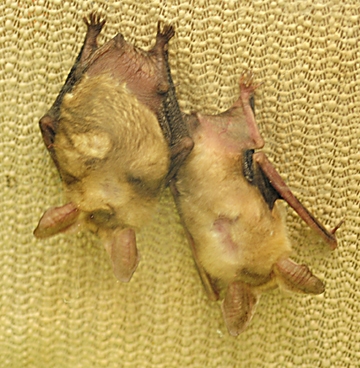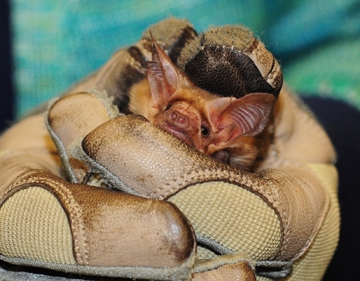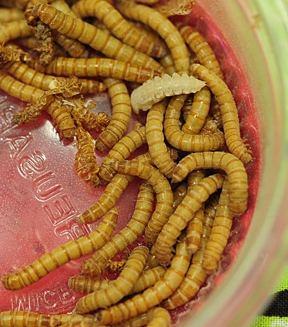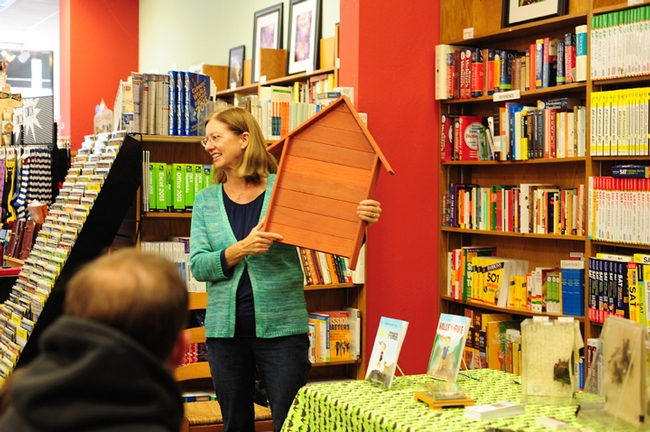
Yolo County Farm Advisor Rachael Freeman Long, who has been researching and writing about bats for 20 years, has two colonies of bats at her ranch in Woodland. The bats eat moths, cucumber beetles, leafhoppers, mosquitoes, midges and water boatmen--when they disperse from the water.
Long is finishing the third book of her children's trilogy, The Black Rose Desert, which stars a boy named Jack, a pallid bat named Pinta and a coyote named Sonny. She'll be talking about bats and signing her books, "Gold Fever" and the newly published "Valley of Fire" on Saturday, Dec. 13 from 9 to 10:30 a.m. in the Common Grounds Coffee shop, 729 Main St., Woodland. She plans to showcase museum specimens, in lieu of live bats.
At a recent educational program in the Avid Reader, Davis, Long and her friend Corky Quirk of Nor Cal Bats, an organization dedicated to research, rehabilitation and release of bats throughout Northern California, entertained the crowd with information about bats. Quirk displayed live bats: two pallid bats, a big brown-bat and a Mexican free-tailed bat, the latter found beneath the Yolo Causeway.

“Pallid bats are native to the western North America,” Long said. “They're unusual in that in addition to catching prey in flight, they will also hunt on the ground for prey, such as crickets, grasshoppers and scorpions. Pallid bats have huge ears and have amazing hearing—they can pick up the sound of a cricket walking on the ground. They are quite agile on the ground.”
“Some migrate, but it's unclear how far they go,” Long said. “In my story they go long distances. Our neighbor regularly gets colonies of pallid bats in the fall in his barn that then move on somewhere else.”
Long, known for her research and scientific publications about bats and bat houses, said her interest “in writing this trilogy is science literacy for kids to teach them about the natural history of bats and the incredible importance of bats in our world for pollination and pest control benefits. Bats are major pollinators of many plants; without bats we wouldn't have tequila as they are the main pollinators of the agave plant from which tequila is made!"

"In my stories,” Long said, “we learn all kinds of wonderful tidbits about bats, including echolocation, migration, that they feed on insects and that 'blind as a bat' is a total myth.”
Long's avid interest in the ecosystem services of bats revolves around how bats can help with pest control in agricultural crops. "For example, we just determined that in walnuts, each bat provides about $6 in pest control services for codling moth control, a major pest in this crop.
Long recalls telling bat stories to her young son “on our long drives into town from our ranch. He loved them so much that one day I finally decided to write them down to share with other children--and adults too!"
Long's trilogy focuses on a cave-exploring boy named Jack, who is 9 years old that summer when his family heads to their Black Rock Range property to search for gold. Jack, wandering off, falls into a cave and gets lost. His new friends, Pinta, the pallid bat, and a coyote named Sonny help him find his way out but then they all find themselves in danger. Other characters in the book include Jack's parents, uncle, and “the bad guys,” a ring of international poachers. One of the poachers is a newly escaped prison inmate roaming Black Rock Range.
What are some generally unknown facts about pallid bats? “They emit a skunk-like smell when disturbed; it's a predator defense,” Long said. “Their wing membranes are like skin; incredibly sensitive.”
Pallid bats usually have one or two bat pups, once per year, and they can live for more than 20 years, Long said. “These bats glean the tastiest parts of insects and leave other pieces behind --legs, wings, heads-- so you can always tell if you have a pallid bat colony. We find them in our bat houses that are up and around Yolo County.”
Long's efforts to educate young children about bats resulted in praised from science journalist Jim Robbins of the New York Times: “Bats play a little known, but vital role in the world.”
Long's books, published by Tate Publishing Co., Mustang, Okla., introduce “young readers to their world in an engaging and entertaining way,” Robbins wrote.
The general public--children and adults alike--can learn a lot about bats in her books. One of her favorite books on bats is "Bats in Question: The Smithsonian Answer Book" by Don Wilson.
Attached Images:

